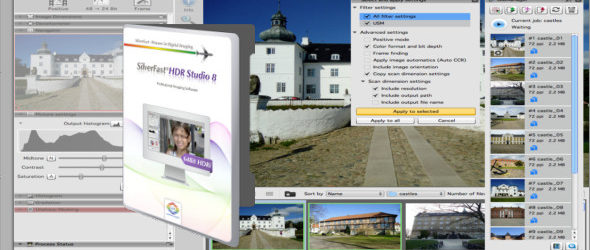
You should expect from power apps like this one to eat up CPU and memory, so the overall performance of the system may be burdened. In conclusion, SilverFast HDR Studio provides an impressive suite of features designed for processing images, offers excellent output results, and is suitable especially for advanced users. An overall powerful and efficient graphic editor There’s also support for batch processing so you can apply the editing mode to multiple items at the same time and a job manager that keeps track of all your actions. You may pick the target photo, specify the scan area and set the output resolution, apply an automatic image correction mode, check out a histogram, adjust gradation (midtone and contrast), correct very dark image areas using the Auto Adaptive Contrast Optimization feature, eliminate grain and noise, remove dust and scratch, as well as pick the output format (TIFF, PSD, JPEG, PDF, JP2) and enter metadata. The best part about SilverFast HDR Studio is that you are guided gradually throughout the optimization mode with the aid of a wizard. They differ according to the prior setup configuration of the image acquisition process. archive, color restoration, editing actions, quick fix for automatic enhancements, highlight protection and shadow details), as well as color mode.ĭepending on the final result that you want to acquire, the utility puts at your disposal different features. You can set up the image acquisition process by providing details about the source (print or image), task (e.g. The WorkflowPilot embeds all the parameters that you need for scanning and processing pictures. You may disable the editing functions that are not used at the current moment, reset the editing parameters to standard values, and activate the expert mode for fine-tuning. In addition, each individual tool dialog may be detached and placed on the desktop. If the interface looks two crowded, you should know that every dialog that integrates an editing parameter can be folded or unfolded separately, or closed. The layout is customizable and you may disconnect the tool dialog from the main window and place it anywhere on the desktop. The GUI looks a bit overwhelming at a first glance as it shows a comprehensive package of features dedicated to the editing process. I already changed Safari as default, no avail (I saw this advice somewhere).
Silverfast hdr 8.8.0r2 update#
In HDR, all SilverFast tools are available: Defining Output Size & Resolution, Auto-Adjust of Highlight/Shadow, Three Part Histogram, Gradation Curves, Selective Color Correction, Unsharp Masking, Color Cast Removal Slider, Color Separation, CMYK-Preview and more.SilverFast HDR Studio is an advanced software application specialized in scanning images into 64- or 48-bit HDR(I) RAW data format, edit photos, and work with an automatic color calibrating mode of the scanner. After update to 8.8.0 Silverfast is not opening correctly. This is achieved by simply selecting the Scan Type pop-up and then choosing 48 Bit HDR Colour, as shown below. First we want to get SilverFast Ai set for raw 48-bit color output (LaserSoft call this 48 Bit HDR Colour mode).
Silverfast hdr 8.8.0r2 64 Bit#
SilverFast HDR enables the user to read and process 48 bit (or 64 bit HDRi) RAW files without being connected to a scanner. Step 1 - Getting SilverFast Ai ready for high-bit scanning. 48 bit files retain all of the information supplied. Normal scanning software saves images into a 24 bit file, discarding the extra information created by the scanner.

Regardless of the effective dynamic range supplied, the file will always become a 48 bit (or 64 bit HDRi) file. In order to save RAW data with extended dynamic range, the 48 bit (or 64 bit HDRi) TIFF format was developed. The images can be scanned and archived into digital format, and then opened at a later date without any loss in quality. The ability to save these 'RAW' files opens up a whole new workflow. This makes the reduction to 24 bit RGB files obsolete.


Silverfast hdr 8.8.0r2 full#
Many of today's scanners have the ability to write the full dynamic range (HDR - High Dynamic Range) of its hardware into TIFF-data.


 0 kommentar(er)
0 kommentar(er)
